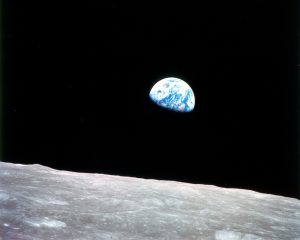Originally posted on Eric Tepletz’s blog
“People have three budgets: a time budget, a complexity budget, and a hope budget,” Al Gore explained to us during a three-day Climate Reality Leadership Corps training last week in Los Angeles. When you are conveying the difficult message of climate change and what needs to be done about it, you must keep in mind that audiences have limited bandwidth in these three areas:
Time: you will have their ear for a relatively short amount of time.
Complexity: this issue is so far-reaching, with so much information to absorb and so many facets to it, you will have to be selective and judicious about what, and how much, data to include (as well as how to present it in a digestible way).
Hope: most important of all, you must not max out your audience’s “hope budget” before getting to the solutions to the problem! You want people to feel empowered and moved to take action, not beaten down by despair.
Simple, perhaps, but not easy.
Because climate change is very, very serious. As in “existential crisis for humanity” serious. If we continue on as we have been, releasing – as Gore pointedly told us – 110 million tons of heat-trapping global warming pollution into our atmosphere DAILY (the equivalent of exploding 400,000 Hiroshima atomic bombs every single day), our ecosystem will be so brutally savaged as to render the planet uninhabitable for up to 50% of land-based species in this century. Which, needless to say, would not bode well for our own. Certainly, we are putting our survival on Earth at incredible risk just by maintaining the status quo.
A certain amount of damage has already been done, with impacts that will continue to be felt indefinitely even if we were to magically stop our CO2 emissions entirely overnight.
What we need now is to do everything in our power to prevent a global catastrophe. It really doesn’t get more serious than that.
The Slideshow
I was among the approximately 2,200 trainees from over 40 countries who participated in the Climate Reality Project‘s training which took place at the Los Angeles Convention Center August 28th – 30th. It was the 39th (and largest) such training helmed by former U.S. Vice President Gore – who has arguably done more than any other individual to raise global awareness about the pressing issue of climate change.
Being immersed in this topic for the bulk of three consecutive days was intense. For me, it was a bit of an emotional roller coaster. There were some inspiring speakers and panelists, to be sure, and an incredible performance by the first-ever “Youth Poet Laureate of the U.S.A.” Amanda Gorman, who recited a poem she wrote specifically for this occasion which knocked me out with its complex rhyme schemes and steadfast spirit of optimism (“Pale blue dot, we will FAIL YOU NOT!”).
But immediately after lunch on the first day, Mr. Gore delivered the “two-hour” (plus) version of his legendary slideshow – the one he has been presenting (and constantly updating and honing) for many years, and which was featured in his groundbreaking film of 2006, An Inconvenient Truth. He warned us ahead of time that there was going to be some difficult and disturbing content ahead. “Hang in there, hope is coming,” he insisted, “but you need to know how serious this is…”
He then proceeded with an hour and forty minutes of unrelenting REALITY: a thorough description of the scenario we now find ourselves in and how we got to this point. How we humans are responsible for a shift in temperatures worldwide, mostly via our burning of fossil fuels and releasing vast amounts of carbon into the air, in effect treating the atmosphere that sustains us like an “open sewer”. Charts and graphs detailing the increasing frequency and magnitude of extreme weather events across the globe. An explanation of how “all storms are different now” given the context of the warmer oceans and hotter air temperatures through which they are taking shape. A seemingly endless barrage of photos and video clips from recent floods, heatwaves, droughts, wildfires, hurricanes, mudslides, and storms the world over, accompanied by statistics on the massive tolls these have taken in terms of the loss of human lives and livelihoods, the destruction of buildings and infrastructures, the political instability caused by the creation of “climate refugees”, the depletion of essential resources such as food and clean water, the spread of infectious diseases, ocean acidification, and the horrifying implications of all of the above continuing to worsen.
As he played tour guide through extreme weather event after extreme weather event, I found myself waiting for him to mention the ones fresh in my mind, while also acknowledging internally, “Oh, yeah, I forgot about that one….and THAT one….and THAT one…”
In a rare moment of semi-comic relief, Gore referred to the nightly news as a “nature hike through the Book of Revelation”, but he also pointed out that in reporting these individual disasters news outlets rarely connect the dots and talk about the bigger picture issue facilitating them: climate change.
Finally, he got to the “solutions” portion of the presentation.
It turns out, while we cannot undo what we have already done, we have the solutions to curb this massive problem RIGHT NOW. Technologically speaking, the answer lies in tapping into renewable energy sources, namely wind and solar, which can more than supply our collective energy needs. Economically speaking, grid parity has practically arrived, meaning that the cost of these clean sources of energy is equal to, or even less than, the cost of the power created by traditional “dirty” sources of energy in most cases (with costs continuing to come down as technologies are improved upon).
WHAT IS NEEDED IS THE POLITICAL WILL to make these changes a matter of public policy. Obviously, the big oil companies have a vested interest in keeping things as they are (they are using the same PR companies, incidentally, that Big Tobacco did back in the day to deny the scientific evidence linking smoking to lung cancer). In a stunning recent example of their desire to profit at the expense of human well-being, they are even seeking government funding to physically protect their facilities from the effects of the climate change they have invested substantial amounts in trying to convince the public is a “hoax”!
The good news is, despite misinformation campaigns and a flock of so-called climate deniers, there are already cities and towns going 100% renewable. Case in point near me – Culver City, CA. Additional good news is that the solutions already at our disposal (clean, renewable energy sources) create changes that are actually good for us as well as the planet. The experience of communities moving toward 100% renewable energy is that it is a lot easier than they thought it would be, AND their bills are going down. A compelling example of this is presented in a segment toward the end of last year’s An Inconvenient Sequel in which Gore visits the town of Georgetown, TX:
The Emotional Arc Over Three Days
To be perfectly honest, by the end of Day One of the training, I was fried.
I have tremendous respect for self-proclaimed “recovering politician” Al Gore, but 100 minutes straight of gloom and doom was hard to take. By the time he got to the solutions/hopeful part of his presentation (which lasted roughly 35 minutes), my own “hope budget” had already been overtaxed, and it was hard for me to receive the “good” news. Add to that a full day’s worth of events, including competing with a roomful of noise when carrying on conversations with partners in breakout sessions among hundreds of others, and I was left feeling overwhelmed and fatigued. I went to bed early that night and slept long.
Day Two was a bit better, but I still felt a little let down afterwards. Sure, the panels were relevant and informative, but only one hour of the day (a breakout session on “Mastering the Presentation”) was devoted to what I thought was the main purpose of the event: to guide us on how to make our own public presentations (a la Gore’s slideshow, albeit much shorter!) to raise public awareness about climate change and encourage people to take action on it.
Day Three was, for me, the redemptive one. Finally I heard my concerns about how to get involved and how to give presentations of our own being addressed (Gore moderated a fantastic panel of previous trainees, and their relatable stories and inspiring examples were helpful and reassuring). And, as promised, Gore himself delivered his “Truth in 10” – the 10-minute (-ish) version of the same slideshow we had witnessed on Day One, which would much more closely mirror the presentations we might give out in the world, depending on our audiences. See below for an example (presentation begins at 2:18 into the below video). I must say that the presentation he gave to us in Los Angeles was much higher-energy, but the content is still great and very digestible here:
There was also an incredible panel on Day Three entitled “Ensuring Climate Equity” which featured young activists calling attention to how the poor tend to be on the front lines and often feel the deleterious effects of industrial pollution before the rest of us (such as by living and going to school a stone’s throw from an oil refinery). They were passionate, smart, determined, and already making a difference in their communities.
Hope crept back in.
Change Happens
In the days following the Climate Reality Leadership Corps training, I am finding that the experience continues to ripple through me, permeating my thoughts and staking a claim in my consciousness. I feel changed by it, and not in an entirely warm-and-fuzzy way. It is a burden to really take in the magnitude of this crisis, and the havoc that we humans have been and are continuing to wreak on this one beautiful planet that is our home. I am observing things somewhat differently and am more sensitive, more attuned to this issue. Daily work tasks seem especially insignificant. Yet, it is still easy to get lost in or numbed by them.
One of the more interesting things unfolding within me is my assessment of the experience after just a little bit of distance from it. While in the thick of it, I questioned – and judged – it. (This feels more like a conference than a training.) But as I’ve been processing it, and reflecting on it, everything seems to make more sense. It seems like it was perfectly designed, in fact!
1) It made sense to first “subject” us to the long version of the slideshow, before presenting the short one a couple of days later. For one, I experienced firsthand what it felt like to have my hope budget depleted, and what affect this had on my ability to feel optimistic about the solutions and empowered to take action in their direction. Also, by the time we saw the short version, the long one was still fresh enough in my mind to make me feel that I had a deeper understanding of the material and how this might shine through my own (short) presentation without my having to expound upon everything in great and morbid detail. I can touch on important topics without inundating my audience, and still get the message across.
2) This couldn’t have been planned, but we had a chance to witness, and experience for ourselves, progress on the political front in real time! California’s SB (Senate Bill) 100 calls for the entire state to generate 50% of its electricity from clean sources by 2026, 60% by 2030, and 100% by 2045. It’s an ambitious (necessarily so) goal that also would serve as a shining example to the rest of the world if passed (especially given that the state of California by itself boasts the fifth largest economy worldwide). The bill had already passed through the California State Senate and was on the floor of the State Assembly during our training. People were following its progress and at one point it was announced that the vote was about to close but that four (Democratic) assemblymembers still had not cast their votes in favor of it. In an instant, the names and phone numbers of these folks were called out, and en masse the climate reality trainees FLOODED them with calls. The following day we got word that, sure enough, the bill moved through the State Assembly and was on its way to Governor Brown’s desk! THAT is how it’s done!
3) It turns out I learned a lot from all of those panel discussions and, more importantly, they have spurred me to further educate myself and better understand the issues at hand. Listening to Hal Harvey talk about “The Four Zeroes” (zero carbon grid, zero emissions vehicles, zero net energy buildings, and zero waste manufacturing), for instance, as a comprehensive solution for addressing climate change in the most impactful way, was one thing. But it sunk in further when I read an op-ed piece by Tom Friedman (whose name I heard mentioned several times during the course of the training) while working on this blog post at home, in which he references those very same four zeroes:
“Clean power, clean cars, clean manufacturing and efficient buildings make everything we want to achieve in our society easier. They can lower our health care costs, cut heating bills for the poor, drive 21st-century innovation, foster decent jobs, mitigate climate change, create more competitive export industries, weaken petro-dictators — and enhance U.S. national security and moral leadership.”
My awareness has been raised, my curiosity and interest have opened up, and I’ve already achieved my first promised (in return for having been given the privilege of acceptance into the training) “Act of Leadership” within a week of attending: the writing and publishing of this post (my first blog post in over a year, as it happens). Not bad for a three-day training!
Conclusion
Al Gore likes to quote the economist Rudi Dornbusch, who said: “[In economics]
things take longer to happen than you think they will, and then they happen faster than you thought they could.” He is convinced that the necessary changes will be made. The issue at hand, however, is WHEN. Timing is of the essence. We are pushing Mother Nature to the absolute limit and ourselves to the edge of a precarious cliff, and we need to make radical changes NOW if we are to have any chance of securing our own future on Earth.
As with all past social movements progressing us forward, change will only come about through public will. It is up to us (as in you and me, not just some hoped for motivated, faceless, abstract others) to insist on switching over to renewable sources of energy – in fact, to demand it. Fortunately, as Gore likes to put it: “POLITICAL WILL IS ITSELF A RENEWABLE RESOURCE.”
So: What can you, one individual, do to combat climate change?
Gore told us:
At the individual level, it’s about personal choices, and conscious consuming.
At the community level: we must change laws/policies! We need TOP DOWN action and policy to address this. There’s simply not enough time for changes to bubble up only from the bottom.
- Speak up, use your voice, register people to vote.
- VOTE. And then hold elected officials accountable to their promises.
- Find out who the decision-makers are. Know with precision who they are and how to get to them. Pester them. Do this in concert with others, not just as a lone wolf. Show up in front of their offices in large groups!
- Educate yourself, and others. Learn about climate change. Write about it. Speak about it.
- Join and support organizations who care about the issue. There are many, including: 350.org, Union of Concerned Scientists, Natural Resources Defense Council, Citizens’ Climate Lobby, and the Sierra Club.
- Consider attending a Climate Reality Leadership Corps training.
“It took me a long time to realize that the scientists had won the argument but were going to lose the fight, because it isn’t about data and science, it’s about power. The most powerful industry is fossil fuel, because it is the richest. At a certain point, it became clear that our only hope of matching that money was with the currencies of movement: passion, spirit, creativity—and warm bodies.” – Bill McKibben
[share title=”Share This Post”]








